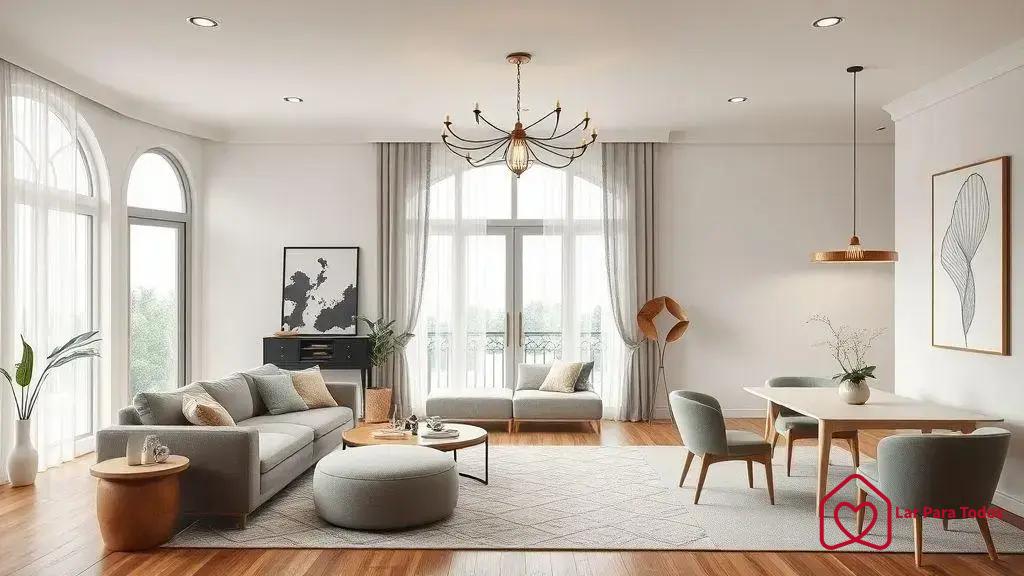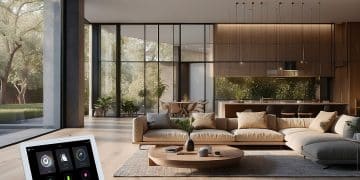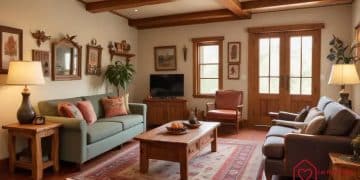Organic curved shapes interior trend: transform your space

Organic curved shapes in interior design enhance comfort. They promote relaxation and foster social interaction, creating inviting spaces.
These soft, flowing lines bring harmony to any living area. They create a peaceful, visually appealing atmosphere in your home.
Have you ever considered how these shapes can enhance your daily living experience? They’re changing the way we think about our spaces.
Defining organic curved shapes in interior design
Organic curved shapes refer to forms inspired by nature. They don’t just add beauty; they bring a sense of calm to the space.
This approach aims to create an inviting and harmonious environment. Soft, flowing lines mimic natural beauty and make the room feel welcoming.
It’s all about creating a peaceful atmosphere that connects with people emotionally. This design trend has a transformative effect.
Characteristics of Organic Curved Shapes
Organic curves can range in size and shape, offering flexibility. They can be soft and fluid or more structured, blending beauty and function.
The key characteristics include fluid lines, natural materials like wood and stone, and a focus on both aesthetics and utility.
These features encourage creativity, allowing for unique and personalized spaces. They help turn rigid, angular rooms into inviting retreats.
The Importance of Natural Inspiration
Natural inspiration is vital for authentic organic design. It helps create spaces that resonate emotionally with people.
Imagine walking into a room where furniture mimics gentle ocean waves. This natural design evokes peace and tranquility.
Seamless transitions between furniture and architecture create flow. Combining textures and colors with curves elevates the design to a new level.
Key benefits of organic curves for modern spaces
Organic curves create a relaxed, inviting environment. They soften harsh lines typically seen in traditional designs.
The benefits go beyond aesthetics, promoting a harmonious, tranquil atmosphere. These curves help create a balanced, welcoming space.
They foster positive interactions, especially in communal areas. The overall vibe is calming, making the space more comfortable.
Improved Flow and Movement
Organic curves encourage natural flow in any room. They replace restrictive sharp angles, creating a more open, expansive feel.
These shapes guide the eye smoothly through the space, enhancing visual appeal. The result is a room that feels larger and more comfortable.
Curved designs improve the flow between areas, reducing visual clutter. This adds a sense of openness and freedom to the environment.
Versatility in Design
Curved shapes are versatile and fit various styles. From minimalist to bohemian, they add personality without overwhelming the aesthetic.
They also have practical benefits, such as enhancing safety. Rounded edges on furniture are especially beneficial for homes with children.
Moreover, curves make the best use of space, allowing for creative arrangements that maintain functionality.
Top materials to achieve the organic look

Choosing the right materials is essential for achieving the organic design. Natural textures and finishes create harmony and visual interest.
Natural wood, stone, and textiles add warmth and character to the space. These materials evoke nature, grounding the room’s aesthetic.
Each material affects the overall feel of the space, so consider how they interact with light and space for maximum impact.
Natural Wood
Wood is a staple in organic design, adding warmth and texture. It enhances the calming atmosphere that curved shapes aim to create.
Reclaimed wood brings history into the design, making each piece unique. It’s versatile, durable, and supports sustainable living.
Wood’s tactile nature connects your space to the outdoors, creating a deeper sense of harmony and calm.
Stone and Marble
Stone and marble bring rugged elegance into organic design. Their earthy textures and patterns complement soft curves beautifully.
With a wide range of colors and textures, these materials offer customization. Each piece is unique, adding character to any room.
Stone also connects the interior with the natural world, adding authenticity to the design. It blends well with various styles.
Textiles
Soft textiles, like linen, cotton, and wool, enhance the organic feel. These fabrics soften sharp lines and add comfort to the space.
Biodegradable or natural fibers support sustainability. They provide variety in colors and textures, creating a more personalized atmosphere.
Combining textiles with organic materials creates a balanced, inviting aesthetic. This adds both beauty and warmth to the room.
Color palettes that complement curved designs
Choosing the right color palette enhances curved shapes. Colors can either amplify or clash with organic lines, so harmony is essential.
Neutral tones provide the perfect backdrop. Beige, gray, and white allow curves to stand out without overwhelming the room.
These colors create a serene environment, bringing calm and balance. They work well with natural materials like wood and stone.
Neutral Tones
Neutral colors enhance the beauty of organic shapes. Shades like beige, gray, and white allow curves to shine.
These tones create a peaceful atmosphere and promote relaxation. Neutral backdrops make rooms feel more spacious and open.
They are versatile, pairing beautifully with bolder accents for a dynamic design. Neutral tones serve as a foundation for other colors.
Soft Pastels
Soft pastels like mint green, pale blue, and blush pink complement curved designs beautifully. These shades add a light, airy vibe to the room.
Pastels reflect light and create a calm, tranquil atmosphere. They work well in spaces like bedrooms and nurseries, where relaxation is key.
These colors create a gentle flow, enhancing the inviting atmosphere. They add a sense of peace and harmony to any space.
Bold Accents
Bold accent colors provide striking contrast to softer tones. Rich hues like deep teal, emerald green, or terra cotta add depth to the design.
These colors highlight unique curved features, drawing attention and adding vibrancy. They work well in small doses for a dynamic effect.
Balancing bold accents with neutrals ensures harmony, making the space feel both lively and cohesive.
Incorporating furniture with organic shapes
Incorporating furniture with organic shapes adds uniqueness and comfort. These pieces soften a room’s overall look and enhance functionality.
When choosing furniture, look for items with smooth lines and rounded edges. Curved sofas and round coffee tables promote relaxation and flow.
These pieces act as focal points while blending seamlessly into the space. They encourage conversation and enhance the overall ambiance.
Choosing the Right Pieces
Look for furniture with rounded edges and gentle curves. Curved sofas and chairs create inviting, comfortable spaces.
Furniture with organic shapes promotes relaxation, making it easier to unwind. These designs fit perfectly into a harmonious interior.
Rounded coffee tables add movement and flow to the room, helping to create an intimate and inviting setting for gatherings and conversations.
Mixing and Matching
Mix organic-shaped furniture with traditional designs for an eclectic look. This adds creativity and personality to your space.
Combining different shapes creates visual interest and balance. For instance, pair a round ottoman with a rectangular table.
Ensure that the colors and styles complement each other. This maintains harmony while adding depth and dimension to the room.
Functionality and Comfort
Beyond aesthetics, organic furniture prioritizes comfort. These pieces support natural body curves, offering ergonomic benefits.
Choose chairs and sofas that allow relaxation. These pieces reflect the soothing nature of organic design.
Organic shapes maximize comfort, enhancing the room’s ambiance. They make the space cozy and inviting.
Real-life examples of the trend in action

Real-life examples showcase how organic curved shapes transform spaces. Designers use these flowing forms to create warmth and harmony.
In modern living rooms, round tables and curved sofas encourage interaction. The lack of sharp edges creates a relaxed atmosphere for gatherings.
Curved furniture makes the space feel more spacious and inviting. It enhances comfort and promotes social connections.
Modern Living Rooms
Curved furniture in living rooms encourages comfort and social interaction. A round coffee table paired with a soft, curvy sectional creates an inviting area.
The lack of sharp edges promotes a relaxed atmosphere. Organic shapes bring people together for meaningful conversations.
The room feels more open, and the design encourages connection. This layout enhances the overall ambiance.
Cozy Bedrooms
In bedrooms, organic shapes create a soothing retreat. Rounded bed frames and soft-edged nightstands enhance comfort and style.
A curved headboard serves as a focal point, contributing to relaxation. The organic design creates a serene atmosphere for rest.
Soft textiles and calming colors complete the look, transforming the bedroom into a peaceful haven where relaxation and comfort take center stage.
Chic Dining Spaces
Dining areas also benefit from organic shapes. A curved dining table paired with rounded chairs creates a cozy, inviting space.
Curved edges improve comfort during meals, making dining more enjoyable. Organic shapes add warmth and elegance to the room.
These design choices make the dining area both functional and beautiful, enhancing the overall experience.
FAQ – Questions about the organic curved shapes interior trend
What are organic curved shapes in interior design?
Organic curved shapes refer to furniture and design elements that feature soft, flowing lines instead of sharp angles, creating a more inviting and cozy atmosphere.
How do organic shapes benefit a living space?
Organic shapes promote relaxation and enhance social interaction by creating comfortable, flowing environments that encourage connection among people.
Can I mix organic shapes with traditional furniture?
Yes, mixing organic-shaped furniture with traditional pieces can create an eclectic and personalized design, adding depth and visual interest to your space.
What materials are best for showcasing organic curves?
Materials like natural wood, stone, and soft textiles complement organic curves, enhancing their aesthetic while adding warmth and comfort to the design.





